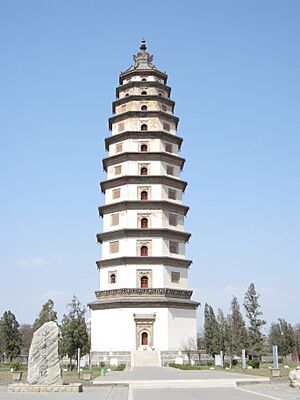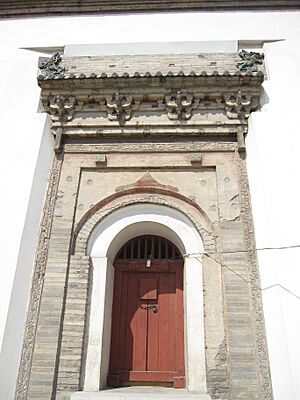Liaodi Pagoda facts for kids
Quick facts for kids Liaodi Pagoda |
|||||||||||||||||||
|---|---|---|---|---|---|---|---|---|---|---|---|---|---|---|---|---|---|---|---|
| Traditional Chinese | 料敵塔 | ||||||||||||||||||
| Simplified Chinese | 料敌塔 | ||||||||||||||||||
|
|||||||||||||||||||
The Liaodi Pagoda (Chinese: 料敌塔; pinyin: Liàodí Tǎ) is an amazing ancient tower in Dingzhou, Hebei Province, China. It's the tallest old Chinese pagoda still standing today. It's also the tallest brick pagoda in the whole world!
This incredible building was finished in the year 1055. It was built during the Song dynasty (960–1279), a time when China was very advanced. The pagoda is about 84 meters (276 feet) tall. It sits on a big platform with eight sides, like an octagon. When it was built, it became taller than any other pagoda around.
Contents
Building the Liaodi Pagoda
Work on this stone and brick pagoda started in the year 1001 AD. This was during the rule of Emperor Zhenzong of Song. The emperor wanted a safe place to keep important Buddhist scriptures. These were holy writings brought from India by a Chinese monk named Huineng.
The pagoda was finished in 1055 AD, when Emperor Renzong of Song was in charge.
Why the Pagoda Was So Important
The Liaodi Pagoda was built in a very important spot. This area was close to the northern border of the Song dynasty. The Song dynasty often had conflicts with their rivals, the Khitan people from the Liao dynasty.
Because it was so tall, the pagoda was perfect to use as a watchtower. Soldiers could stand at the top and look for any enemy movements. They could see if the Khitan army was coming from the north.
At first, the pagoda was called the Kaiyuan Pagoda. But because it was used for military purposes, its name changed. It became known as the 'Liaodi' pagoda. This name means 'foreseeing the enemy's intentions.' It shows how important it was for defense.
Other Tall Pagodas
There is another pagoda in Shaanxi Province called the Chongwen Pagoda. It is similar in height and design to the Liaodi Pagoda. The Chongwen Pagoda was completed much later, in 1605, during the Ming dynasty.
It stands at about 79 meters (259 feet) tall. This makes it the second tallest pagoda built in ancient China.
What Makes the Liaodi Pagoda Special
The Liaodi Pagoda has many interesting parts. Each floor has stone eaves that stick out a little more than the one below. There are also doors and windows on each floor. Some of the windows are just for show, especially on the four sides of the eight-sided structure.
The very first floor has a balcony that goes all the way around. This would have given great views!
Inside the Pagoda
You can see inside the tower because some parts of its walls are open. This lets you see how thick the walls are. At the very top of the pagoda, there's a crowning spire. This spire is made of bronze and iron.
Inside, there's a big staircase that winds all the way up. It has flat areas, called landings, on each floor. This staircase goes from the bottom floor right up to the top.
Brick brackets help support these landings on each floor. However, from the eighth story up, there are no brackets supporting the vaulted ceiling. Inside the pagoda, there's also a large pillar shaped like another pagoda. You can see this from the inside and from the cut section of the wall.
The walls of the pagoda have beautiful painted murals. There are also stone tablets, called steles, with amazing Chinese calligraphy. These artworks are from the Song period, when the pagoda was built. They help us understand what life was like back then.
See also
- Chinese architecture
- Architecture of the Song dynasty
- History of architecture
- List of tallest structures built before the 20th century



